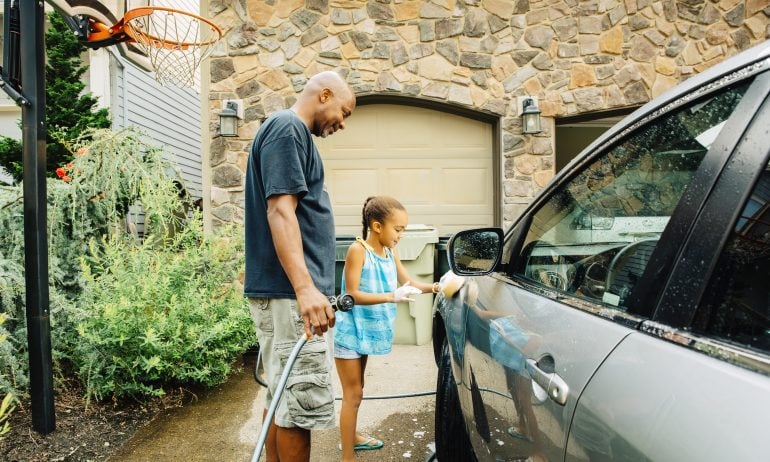What Is Full Coverage Car Insurance?
Full coverage car insurance combines liability, comprehensive and collision insurance to cover you in most scenarios.

Many, or all, of the products featured on this page are from our advertising partners who compensate us when you take certain actions on our website or click to take an action on their website. However, this does not influence our evaluations. Our opinions are our own. Here is a list of our partners and here's how we make money.
Full coverage car insurance is typically a combination of comprehensive, collision and liability coverage.
It provides coverage for most scenarios, including damage to your car from the weather, an at-fault accident, hitting an animal or vandalism.
You may want or need full coverage auto insurance if you have a new car, live in a place with extreme weather conditions or have an auto loan or lease.
You may have heard about full coverage car insurance while shopping for coverage. But while that sounds like a single type of insurance that covers you in every possible situation, the truth is “full coverage insurance” usually refers to a combination of separate coverage types.

See what you could save on car insurance
Easily compare personalized rates to see how much switching car insurance could save you.Full coverage insurance explained
Full coverage car insurance typically refers to an auto policy that combines liability insurance with comprehensive and collision insurance. With full coverage insurance, your policy will pay for damage to your car and also covers injuries or damage you cause to others.
Full coverage car insurance isn’t required by law. Most states require a minimal amount of liability insurance, but this only covers damage or injuries you cause to others, not your own injuries or car repairs. Auto insurance with full coverage offers extra financial protection after a crash beyond your state’s minimum requirements, so it is generally recommended if you can afford it.
Full coverage car insurance is typically a combination of these three types of coverage:
Liability insurance pays for other people’s medical bills and property damage from an accident you cause.
Collision insurance pays for damage to your own vehicle after an accident.
Comprehensive insurance pays for damage to your vehicle from circumstances outside your control, like natural disasters or theft.
What does full coverage car insurance cover?
Full coverage insurance can apply in most situations, such as dealing with damage to your car from a storm, an at-fault accident, hitting an animal or even vandalism. And if your car is stolen, your full coverage insurance will even pay out the current value of your car (minus your insurance deductible) so you can afford to replace it.
Below are the coverage types you may get in a full coverage insurance policy and how they work.
Coverage type | What it pays for |
|---|---|
Bodily injury liability | Medical costs due to injuries or deaths from an accident you caused. |
Property damage liability | Repair costs for property you damaged in an accident. |
Uninsured motorist bodily injury liability | Medical costs after an accident with an uninsured driver. |
Uninsured motorist property damage coverage | Repair costs after an accident with an uninsured driver. |
Collision coverage | Repair costs to your car if you crash with another vehicle or run into an object, such as a tree or a telephone pole. |
Comprehensive coverage | Repair costs from events outside your control — including weather, hitting an animal while driving, theft and vandalism. |
To learn more about these and other types of car insurance coverage, use our tool below.
You can think about full coverage insurance like a knight’s suit of armor. You start with your state’s mandated car insurance requirements, just like a knight starts with a breastplate — the bare minimum. But sometimes that amount of protection isn’t enough. Opting into additional coverage types will give you financial protection in even more areas, just like how a knight with more armor pieces can protect other parts of their body.
But full coverage auto insurance doesn’t cover everything, and it may or may not include all the types of insurance listed above. If you want extras like new-car replacement insurance, emergency roadside assistance or custom parts and equipment coverage, you may need to add them to your policy separately.
» MORE: Types of car insurance
Cost of full coverage car insurance
The national average for full coverage auto insurance is $2,294 per year, or about $191 a month, for a 35-year-old good driver with good credit, according to NerdWallet’s April 2025 analysis. Full coverage can often be more than three times the price of minimum-required liability insurance, which is why it pays to shop around and compare quotes from multiple companies to find the cheapest rate.
Average annual full coverage car insurance premium by company
Below is the average cost of full coverage auto insurance for a 35-year-old good driver with good credit from some of the country’s largest insurers.
| Company | Median rate |
|---|---|
| Allstate | $2,949 |
| American Family | $2,132 |
| Farmers | $3,849 |
| GEICO | $1,993 |
| Nationwide | $2,683 |
| Progressive | $2,164 |
| State Farm | $2,321 |
| Travelers | $1,751 |
| USAA* | $1,458 |
*USAA is only available to military, veterans and their families.
Average annual full coverage car insurance premium by age
Your age is a big factor in your full coverage insurance cost. Below is the average cost of full coverage auto insurance by age for drivers with good credit and a clean driving record.
| Age | Median rate |
|---|---|
| 20 | $4,673 |
| 30 | $2,365 |
| 35 | $2,294 |
| 40 | $2,231 |
| 50 | $2,076 |
| 60 | $1,991 |
| 70 | $2,134 |
Do I need full coverage car insurance?
Full coverage auto insurance can be extremely beneficial to have, but it typically isn’t required unless you have an auto loan or lease. You may still want to add it to your policy, however. Full coverage insurance may be a good idea if you:
Drive a new or expensive car.
Regularly commute in heavy traffic.
Live in a place with extreme weather, high car theft rates or a high risk of animal collisions.
Can’t afford to repair or replace your car if it’s wrecked or stolen.
However, full coverage may not make sense if you drive an older vehicle. Comprehensive and collision insurance will only reimburse you up to the value of your car at the time it’s damaged or stolen. And these types of coverage usually come with an insurance deductible, which is an amount you’re expected to pay out of pocket toward repair or replacement costs.
If your deductible is more than the value of your car, you may want to skip these coverage types.
For example, let's say you have a car worth $1,500. You opted into comprehensive and collision insurance, which costs $600 per year with a $1,000 deductible. But if you get into a car accident and total your car, the most you’ll get from your insurer is a $500 check, which is your car's value minus your deductible. In this case, you're left with $500, which is $100 less than what you paid for the coverage.
Although full coverage car insurance doesn't make sense here, you'll still need to buy minimum coverage to legally drive.
Not sure if you need full coverage auto insurance? Checking your car’s current value can help you decide whether full coverage insurance makes sense.
How to save on full coverage car insurance
Shop around. It’s important to shop around if you want to find cheap auto insurance. Compare rates with at least three companies to find the cheapest rate for you.
» MORE: Get free car insurance quotes
Look for discounts. There are car insurance discounts for everything from getting good grades to owning a new car. Call your agent to confirm what’s offered to maximize your savings.
Consider increasing your deductible. One way to lower your car insurance bill is by raising the deductible, which is what you’re on the hook for before insurance pays out. Doing this will lower the overall cost of your policy, although savings vary by company.
Avoid traffic infractions. Speeding tickets, accidents and DUIs can increase your car insurance rates drastically, even after one incident. These infractions can stay on your record for three to five years, so make sure to drive cautiously if you want the cheapest rates.
Work on your credit. Although it isn’t always easy to build your credit, it can impact your auto insurance bill. Our analysis of the average cost of car insurance found having poor credit can increase your rates more than a recent DUI for some drivers. There are exceptions to this, however: California, Hawaii and Massachusetts don't allow insurers to use credit when determining car insurance rates.
» MORE: How to build credit
NerdWallet averaged rates based on public filings obtained by pricing analytics company Quadrant Information Services. We examined rates for men and women for all ZIP codes in all of the 50 states and Washington, D.C. Although it’s one of the largest insurers in the country, Liberty Mutual is not included in our rates analysis due to a lack of publicly available information.
In our analysis, “good drivers” had no moving violations on record; a “good driving” discount was included for this profile. Our “good” and “poor” credit rates are based on credit score approximations and do not account for proprietary scoring criteria used by insurance providers.
These are median rates, and your rate will vary based on your personal details, state and insurance provider.
Sample drivers had the following coverage limits:
$100,000 bodily injury liability coverage per person.
$300,000 bodily injury liability coverage per crash.
$50,000 property damage liability coverage per crash.
$100,000 uninsured motorist bodily injury coverage per person.
$300,000 uninsured motorist bodily injury coverage per crash.
Collision coverage with $1,000 deductible.
Comprehensive coverage with $1,000 deductible.
In states where required, minimum additional coverages were added. We used the same assumptions for all other driver profiles, with the following exceptions:
For drivers with minimum coverage, we adjusted the numbers above to reflect only the minimum coverage required by law in the state.
We changed the credit tier from “good” to “poor” as reported to the insurer to see rates for drivers with poor credit. In states where credit isn’t taken into account, we only used rates for “good credit.”
For drivers with one at-fault crash, we added a single at-fault crash costing $10,000 in property damage.
For drivers with a DUI, we added a single drunken-driving violation.
For drivers with a ticket, we added a single speeding violation for driving 16 mph over the speed limit.
We used a 2022 Toyota Camry LE in all cases and assumed 12,000 annual miles driven. We analyzed rates for drivers of the following ages: 20, 30, 35, 40, 50, 60 and 70.
These are rates generated through Quadrant Information Services. Your own rates will be different.


